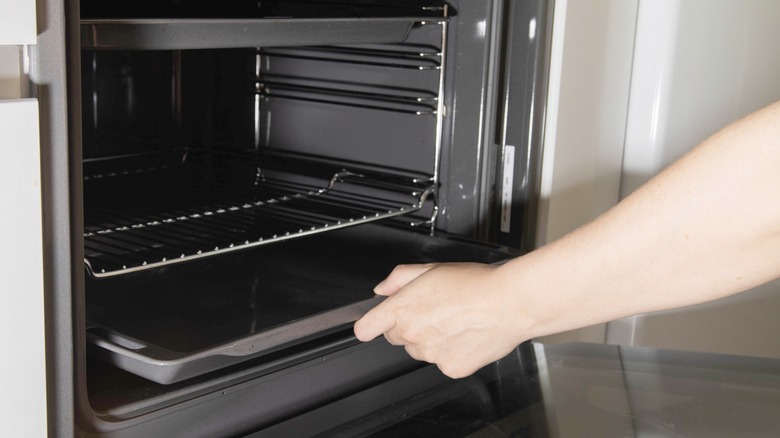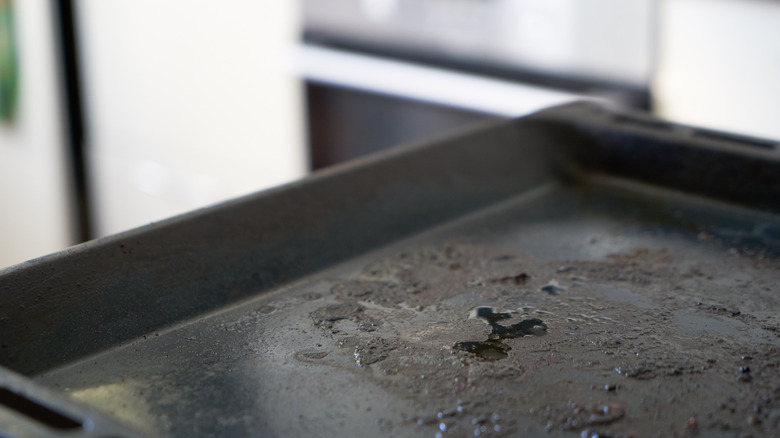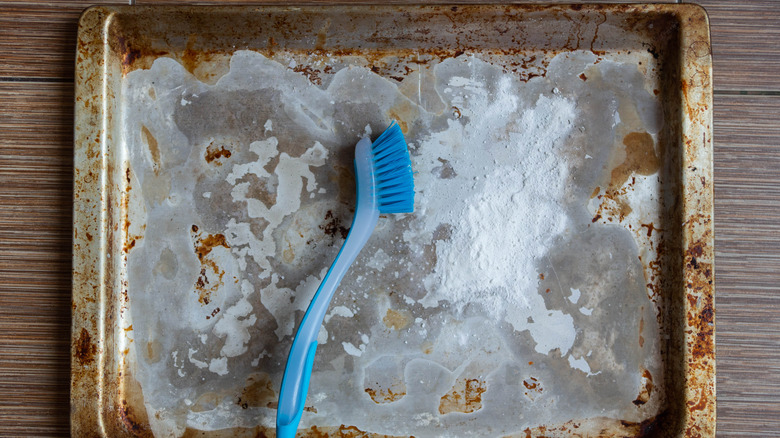The Secret To Shiny Baking Sheets Is Hiding In Your Pantry
There's nothing like baking cookies on a shiny new aluminum baking sheet and snapping a few before and after pictures for Instagram. A good set of baking sheets can have quite the lifetime in one's culinary pursuits, both sweet and savory. The only bitterness comes from the natural fading of the pans over time as they lose their shine, becoming "seasoned" with their frequent use. The seasoning of the pans can actually provide better flavor for your food, too! And while natural aging of your pans isn't necessarily a bad thing, they can be a sight for sore eyes. Nevertheless, it is possible to restore baking sheets to their shiny beginnings with a little elbow grease. All you'll need to do so is reach into your pantry for some cream of tartar to get started.
Cream of tartar is a white, powdery substance that is a byproduct of winemaking. It is scientifically known as potassium bitartrate and is derived from tartaric acid. It is a great cleaner because it has acidic properties that help break down stains and residue on metal surfaces. Furthermore, it acts as a natural abrasive, making it effective in removing tough stains and restoring shine. Cream of tartar is non-toxic and environmentally friendly, making it a safe option for cleaning. Its gentle yet powerful cleaning properties also make it an ideal choice for deep cleaning baking trays, as it can remove burnt-on food particles and restore shine without damaging the metal surface.
How to use this DIY cleaner
To restore the shine to your baking pans, you'll need to start by making a DIY cleaner using cream of tartar and warm water. In a small bowl, combine 2 tablespoons of cream of tartar with enough warm water to form a paste. Stir well until the tartar is fully dissolved. Using a sponge or a soft cloth, apply the cream of tartar paste to the baking sheet. Make sure to cover the entire surface, focusing on any stained or dull areas.
Next, allow the cream of tartar paste to sit on the baking sheet for at least 15 minutes, but overnight if possible. This will give the cleaner enough time to work its magic and break down any stains or residue. Use a non-abrasive sponge or brush to gently scrub the baking sheet. Pay extra attention to any stubborn stains or burnt-on food particles. Once you're satisfied with the scrubbing, rinse the baking sheet thoroughly with warm water. Finally, dry it with a clean towel or let it air dry. You will be amazed at the restored shine and cleanliness of your baking sheet.
For extra tough spots, you can elevate the cleaning power of the cream of tartar paste by pouring distilled white vinegar over the pan and allowing it to sit overnight. The same process can also be applied with a sprinkle of cream of tartar and hydrogen peroxide. Rinse and dry to reveal the shine!
Caveats when using this DIY cleaner
While this method can work well on some baking sheets, it's important to note a few caveats when using this DIY cleaner. You'll want to avoid using it on non-stick or coated baking sheets, as cream of tartar can be abrasive and may damage the coating. Always test the cleaner on a small, inconspicuous area of the baking sheet before applying it to the entire surface. This will help ensure that the cleaner doesn't cause any adverse reactions or damage.
If the baking sheet has heavy stains or burnt-on food, you may need to repeat the cleaning process or use a more powerful cleaner. One alternative that does well at restoring the gleaming shine to aluminum or stainless steel pans is Bar Keepers Friend. Similar to cream of tartar, it is a powdered cleanser intended for cleaning tough spots on culinary-grade metals. To use this method, create a paste from the powder and water and spread it over the pan, allowing it to sit for a minimum of 30 minutes before scouring it with a brush or sponge. Wash with soap and water and finish with a rinse.
One final method that is specifically for aluminized baking sheets is to use oven cleaner. Spray the pan with the cleaner and allow it to sit for at least 15 minutes. Scrub the pan with steel wool and finally wash with soap and water to reveal a shiny finish on your previously worn baking pans.


